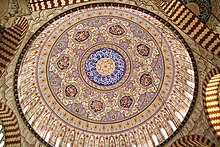

Fractal art is a form of algorithmic art created by calculating fractal objects and representing the calculation results as still digital images, animations, and media. Fractal art developed from the mid-1980s onwards.[2] It is a genre of computer art and digital art which are part of new media art. The mathematical beauty of fractals lies at the intersection of generative art and computer art. They combine to produce a type of abstract art.
Fractal art (especially in the western world) is rarely drawn or painted by hand. It is usually created indirectly with the assistance of fractal-generating software, iterating through three phases: setting parameters of appropriate fractal software; executing the possibly lengthy calculation; and evaluating the product. In some cases, other graphics programs are used to further modify the images produced. This is called post-processing. Non-fractal imagery may also be integrated into the artwork.[3] The Julia set and Mandelbrot sets can be considered as icons of fractal art.[4]
It was assumed that fractal art could not have developed without computers because of the calculative capabilities they provide.[5] Fractals are generated by applying iterative methods to solving non-linear equations or polynomial equations. Fractals are any of various extremely irregular curves or shapes for which any suitably chosen part is similar in shape to a given larger or smaller part when magnified or reduced to the same size.[6]
- ^ Trivedi, K. (1989). "Hindu Temples: Models of a Fractal Universe". The Visual Computer. 5 (4): 243–258. doi:10.1007/BF02153753. S2CID 29185088.
- ^ Bovill, Carl (1996). Fractal geometry in architecture and design. Boston: Birkhauser. p. 153. ISBN 0-8176-3795-8. Retrieved October 28, 2011.
- ^ Elysia Conner (February 25, 2009). "Meet Reginald Atkins, mathematical artist". CasperJournal.com. Archived from the original on April 20, 2012. Retrieved October 28, 2011.
- ^ Burger, Edward B.; Michael P. Starbird (2005). The heart of mathematics: an invitation to effective thinking. Springer. p. 475. ISBN 1-931914-41-9. Retrieved October 30, 2011.
- ^ Steven R., Holtzman (1995). Digital Mantras: The languages of abstract and virtual worlds. MIT Press. p. 241. ISBN 0-262-58143-4. Retrieved October 28, 2011.
- ^ Fractal – Definition. Free Merriam-Webster Dictionary.